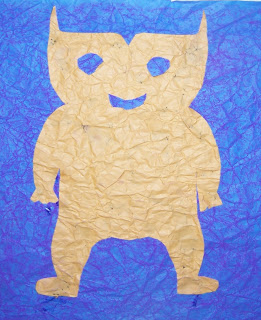A three or four day weaving lesson for Kindergartners. It began with "measuring" or practice using a ruler as a straight edge and cutting the construction paper loom. Next, they wove paper cut with funky scissors, fabric strips, colored tin foil bent into organic lines, yarn and other textured fiber scraps through their loom. The weaving process took some students one day, others two. When finished I had a sponge painting station set up for students to add (or attempt) a painted pattern design. My students found painting on the multiple surfaces interesting. Fun and wild lesson that grew as we went!
: A blog of inspirations & updates from my life as an artist, educator and human being.
Saturday, January 28, 2012
WiLd WeAvings
A three or four day weaving lesson for Kindergartners. It began with "measuring" or practice using a ruler as a straight edge and cutting the construction paper loom. Next, they wove paper cut with funky scissors, fabric strips, colored tin foil bent into organic lines, yarn and other textured fiber scraps through their loom. The weaving process took some students one day, others two. When finished I had a sponge painting station set up for students to add (or attempt) a painted pattern design. My students found painting on the multiple surfaces interesting. Fun and wild lesson that grew as we went!
Tuesday, January 24, 2012
Saturday, January 21, 2012
Parade Masks
First graders created masks focusing on two objectives: creating a mask that is symmetric and has an expression. I set up supply stations, which allowed them to roam around the room and work together. First step was to fold and cut a symmetrical mask design with some facial features, Then the decorating began with yarn, raffia, construction paper, drawing supplies, foam and wood shapes, pipe cleaners, feathers, beads, puzzle pieces and tape... lots of tape. First graders LOVE tape. I brought each first grade section around the school in a parade fashion to "scare" or maybe rather "entertain" the other classrooms. It was good fun.
Tuesday, January 17, 2012
Liebster Blog Award
I recently won the Liebster Blog Award from the creative and ever inspiring Chesterbrook Academy Elementary School blog!
The goal of this award is to introduce blogs with less than 200 followers. The rules are:
1. Copy and paste the award on your blog
2. Thank the giver and link back to them
3. Reveal your top 5 picks and let them know by leaving a comment on their blog
4. Spread our love of art to other bloggers
The goal of this award is to introduce blogs with less than 200 followers. The rules are:
1. Copy and paste the award on your blog
2. Thank the giver and link back to them
3. Reveal your top 5 picks and let them know by leaving a comment on their blog
4. Spread our love of art to other bloggers
Here are my five picks:
Explore, Enjoy, Collaborate!
Monday, January 16, 2012
Mola inspired
 |
| Threading the needle! |

World Arts Month brought construction paper motifs inspired by traditional Mola designs of the Kuna women of Central America. Materials: layered construction paper, background pieces of construction paper 18 x 18, yarn, tape, hole punch, glue, scissors. Plan for about 5-6 class periods (third grade) These brighten our hallways during these gloomy January days.
Saturday, January 7, 2012
Thursday, January 5, 2012
Amate Bark Paintings
Bird Paintings inspired by Amate Bark paintings. I have always loved the bright pigments against the natural tones of the paper, and have always wanted to create/teach this lesson. When I began to look through all of the lessons/examples from the previous art teacher I found a good selection of amate bark paintings done in a variety of styles. These examples are from my first grade students.
Three day lesson...
Day 1- Introduction to project with visuals and sketching bird and plant designs
Day 2- crumple and unfold brown butcher paper squares (appox. 18 x 18) about five times, then iron.... yes first graders ironing- no accidents thankfully! Transfer sketch design onto "bark", trace over with thick sharpie or black tempera paint
Day 3- Paint bird patterns, ferns, and border patterns with neon tempera paint and white/glow in the dark.
Monday, January 2, 2012
Cork hOoks
Winter break has been a great time to catch up on DIY inventions that have been put on hold during the school year. I was in need of hooks in our kitchen for towels, aprons, etc.. so I did some digging in my collection of odd recycled objects and found a spool of old thick gaged wire, and some corks. Simply, drill a hole into the cork about 3/4 of the way through to stick the wire in. Finish the hook by making a swirl to hang from the wall. To make the towel bar drill all the way through the cork (about 5 or 6 corks) and string onto the wire like beads, leaving enough wire at each end to create a swirl to hang. Easy, limited materials and time invested in these kitchen hooks!
Subscribe to:
Posts (Atom)



































